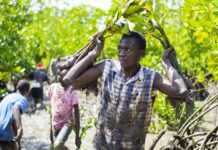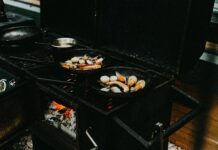By Ruth Keah
Kilifi County, Kenya: Juliana Fondo is a livestock farmer in her Mikomani village home in Rabai Sub-county on the Kenyan Coast. She keeps cows, chickens, and geese.
The cow dung from her six cows is gold to her. She uses the waste to run her biogas stove, which she uses for cooking.
“The biogas has made my work easier, it is very clean, no inhaling of smoke and I can cook anytime without fear that it will run out. It can be used for eight hours of non-stop cooking for my family of five children,” says Ms Fondo.
“If each homestead had this type of clean cooking method, we would not have much destruction of our forests.”
Fondo says the Ministry of Energy in collaboration with the County Government of Kilifi installed the biogas plant for her. She says many people visit her to learn about the project and she receives at least two guests every month.
She says the biogas digester took one month to be built at no cost to her since it was a pilot project.
Before venturing into using biogas, Fondo says she would spend many hours looking for firewood and charcoal. At times she had to buy trees and turn them into wood fuel, a practice that was very expensive.
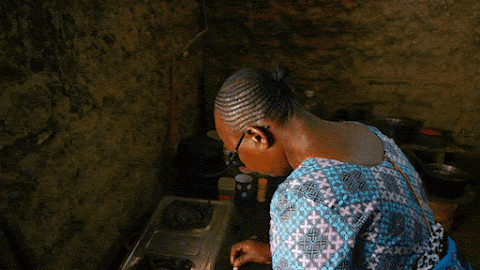
However, for the five years she has been using biogas, she has all the time to engage in other house chores, never spends money on buying firewood or charcoal, and also saves trees.
Fondo says many people have at least one or two cows in their neighborhood but lack the knowledge of how to make the biogas. She urges the county and national governments to create awareness for everyone who keeps cattle.
“If the government helps people build the biogas, then the trees we are planting won’t be cut down for firewood and charcoal, hence conserving our environment,” she says.
Fondo says it pains her to see women walk into forests to cut down trees for firewood. The destruction, she says, has led to the long droughts experienced in the country.
“I plant trees and advocate for people to do so. I spend sleepless nights when I imagine that our kaya will one day disappear due to human activities and that we shall have nothing to show our future generations,” she says.
“When we plant trees we will get rain and enough food, and when the community has food, children will go to school and we will live a happy life.”
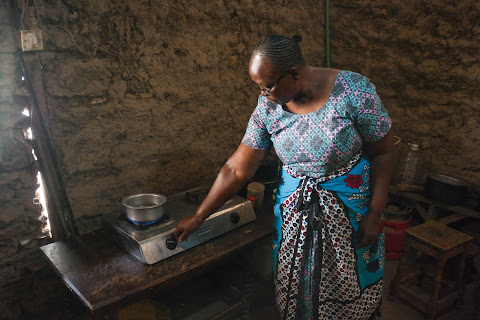
Juliana lighting her gas cooker at her home in Kilifi County, which uses biogas to generate the cooking gas/ Ruth Keah.
Selina Juma from Makobeni village is the chairperson of Chauringo-Makobeni Dairy. The group specializes in livestock keeping.
Ms. Juma says she used to walk for six hours to the nearest Kaya forest to look for firewood, an exercise which she says was not only wasting her time but also exposing her to the risk of sexual and gender-based violence on her way to the forest.
However, thanks to the Climate Action Plan, she now has a small digester to make biogas using cow dung from her two cows.
“This biogas is a very important thing to me, even my husband cooks for himself when I’m away without any problem. You also don’t destroy the environment by cutting down trees,” she says.
Ms. Juma, who is in her early 60s, says the use of biogas has kept her fit and healthier because she does not do a lot of tiring household chores such as fetching firewood, fetching water, and inhaling smoke while cooking. Instead, she gets a lot of time to rest.
“If women get relief from walking for long distances to look for firewood and water, many of us will always look young, healthy, and live long. I urge women to invest in biogas and stop cutting trees so that we can conserve our environment,” she says.
One of the challenges the women encounter when using biogas is a lack of water for mixing the cow dung. Due to climate change and the resultant long droughts, the cows also cannot get enough grass to feed on. This means they produce very little waste.
To make biogas, the women collect cow dung from the zero-grazing units, then put it in a mixing chamber, where it is mixed with water and crushed using their hands into finer particles.
The dung is then allowed into the digester with a gas holder, where biowaste undergoes anaerobic digestion to produce a methane gas, which is flammable.
The gas is then piped into the house where it is used for cooking and lighting.
Finally, a tank collects the waste that has been used to produce the methane gas. This waste is referred to as slurry, which is used as fertilizer.
According to the Poor People’s Energy Outlook 2019, on average households in Kenya spend five hours 16 minutes per day collecting and preparing fuel and cooking. Switching to clean cooking solutions reduces the duration by 37 percent to three hours 18 minutes per day.
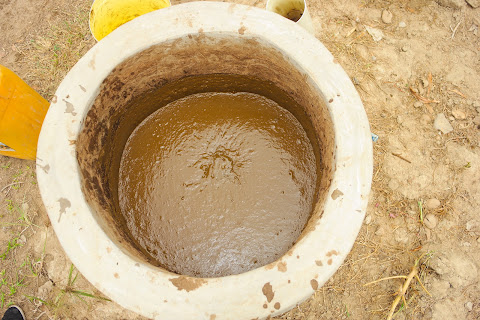
The Director of Energy in Kilifi County, Wilfred Baya, says they have trained more than 100 youth and women in the six sub-counties to embrace clean cooking methods, especially the use of briquettes and biogas.
“Since we started the project of training and urging people to use clean cooking methods in 2018, the rate at which trees are being cut has reduced by 10 percent,” says Mr Baya.
Clean Cooking Association of Kenya (CCAK) Communications Officer Brian Murumba says recycling cow dung into biogas helps reduce energy costs for a family.
The CCAK is one of the CSOs funded by the Worldwide Fund for Nature (WWF-Kenya) to implement locally-led climate action under the Voice for Joint Climate Action (VCA) project.
Murumba says they have so far engaged more than 70 women in Kilifi County who are being trained on clean cooking methods, including the use of biogas.
“One main objective of recycling waste into energy generating commodity whether for cooking or lighting is to cut carbon emissions and improve the livelihoods of families,” he says.
Prof Bernard Fulanda, an associate professor in marine science and a climate change expert, says clean cooking helps in reducing carbon emissions.
“The carbon emissions can be reduced in varying quantities from household to household depending on how they use the clean renewable energy. Some can cut up to 100 percent but on average it can be reduced by 60-70 percent,” says Prof Fulanda.
rkeahkadide@gmail.com


